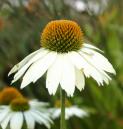The seed of Sina'pis al'ba Linné.
BOTANICAL CHARACTERISTICS.—Stem 1 to 2 feet high, round, smooth. Leaves lyrate-pinnatifid. Flowers yellow. Silique hispid. Seeds whitish, with the embryo folded upon the surface of one of the cotyledons, which is also folded so as to inclose it.
HABITAT.—Asia and Southern Europe; cultivated.
DESCRIPTION OF DRUG.—The principal difference between this and black mustard is that of color and size, being 1 to 2 mm. in diam., of a yellowish color, and less pungent. The oily embryo consists of a curved caudicle and two cotyledons, one folded over the other. Both the black and white seeds are practically free from starch. Commercial ground mustard is an unctuous yellowish powder which cakes on pressure; it is usually a mixture of the ground white mustard (dull yellow) and the black mustard (yellowish-green). The mixture is, however, often rendered brighter by the addition of turmeric; when this is the case, it will respond to the test for starch, and will acquire a red-brown color with a solution of borax or boric acid. The "limit of starch" test of the U.S.P., page 394 (8th ed.), will betray dilution with starchy substances. Moistened with water the powder quickly develops a pungent odor.
Powder.—Characteristic elements: See Part iv, Chap. I, B.
CONSTITUENTS OF BLACK AND WHITE MUSTARD.—Both contain a fixed Oil, 22 to 23 per cent.; mucilage about 19 per cent. Both seeds contain the ferment myrosin, the white having usually the larger quantity. The quantity of myrosin in these seeds is quite variable, sometimes being as low as 2 per cent., then as high as 18 per cent. A glucoside exists in the white mustard, sinalbin (C30H44N2S2O16), which, decomposed by myrosin, yields glucose, sinapine sulphate, and a fixed oil, which is the sulphocyanate of acrinyl, and is found to be identical with para oxyphenylacetic acid. H. Salkowski manufactured this principle synthetically. The black mustard contains sinigrin (C10H18KNS2O10), which yields, when decomposed by the ferment myrosin, glucose, potassium sulphate, and a volatile oil, allyl isothiocyanate (CS:K.C3H5), the common mustard oil. Ash, not exceeding 9 per cent.
ACTION AND USES.—Same as Sinapis Nigra. Average dose: 2 dr. (8 Gm.).
Preparation of Sinalbin.—Extract powdered white mustard with benzene (CH) to remove oil. Treat the dried dregs with four times its weight of boiling alcohol. Filter the alcoholic liquid while hot. On standing in a cool place the liquid deposits crystals of sinalbin.
Preparation of Sinigrin.—Oil is removed, as in the case of sinalbin. The oil cake is then boiled in alcohol and evaporated to dryness. Repowder and extract with cold water. Treat the resulting liquid with barium carbonate and evaporate on a water-bath to dryness. Extract the residue with strong boiling alcohol and filter while hot. On cooling and standing the solution deposits silky needles of sinigrin, or potassium myronate.

